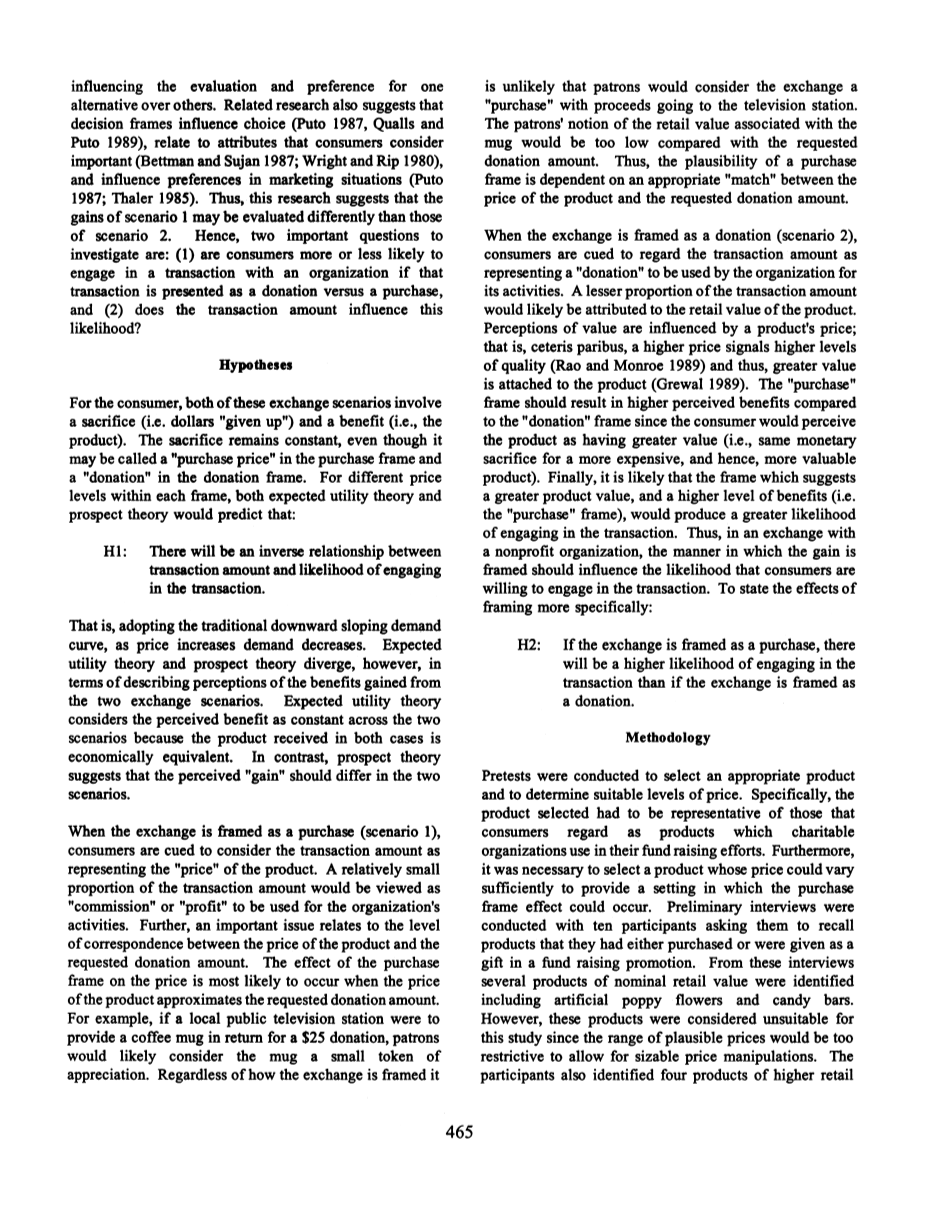价格的框架效应对消费者参加非营利组织募捐的影响
Joseph M. Jones,克拉克森大学
Kyle Zolner,伊利诺伊大学
Larry D.康波,克拉克森大学
Jeanne L. Munger,克拉克森大学
摘要 本文提出了一个实验调查即通过改变产品的提供方式在非营利组织筹集资金。前景理论被用来作为一个框架,用于描述两种可供选择的框架方案:产品购买与产品的礼物作为回报的捐赠。 本研究探讨在框架的情况下,消费者在不同的价格水平下从事交易具有恒大的可能性。该实验表明,价格对交换框架是作为一种捐赠框架还是一种购买框架将产生很大的影响。
公益组织、慈善机构往往将把产品推销给社会公众作为募捐的一种手段。 组织可以选择将产品的购买产品作为交易或者作为捐赠,以供大众欣赏。对于这两种情况,传统的经济思想即期望效应理论表明,消费者对于交易的理性判断完全基于交换的成本和收益。因此,单独的交易框架(即将货币金额作为购买价格与捐赠)不应该对交易的可能性产生任何影响.。然而,最近对框架的影响的调查表明,以何种方式交换框架可能会影响消费者参与交易的可能性(Kahneman和Tversky和Kahneman 1979,1984;特韦尔斯基1981;泰勒1985)。 本研究的目的是为了研究框架效应对消费者可能从事非营利组织交易的影响。
有几种策略可供非营利组织利用产品筹集资金。其中一个策略是要求消费者购买一个产品,在以下情况下会有表现:
情况一:产品以特定价格出售,收益将用于支持购买请求的非营利慈善组织.。
另一种策略可能是要求捐赠,并提供一个产品,以支持组织的支持,由以下情况:
情况二: 一个非营利性的慈善组织寻求特定的捐款来支持其工作,并提供一个产品升值 。
根据预期效用理论,两种交换方案中,消费者在货币方面,经济成本和效益为同一本质,是等价的(冯诺依曼和Morgenstern 1944)。因此,双方的情况应得到相同的效用,或满足。
框架效应
卡尼曼和特韦尔斯基(1979,1984;特韦尔斯基和卡尼曼前景理论1981)提供了一个更具描述性的,包括语法在同等经济方案差异概念的理论视角。相反,基于期望效用理论的预测,前景理论认为偏好是由各种成果的影响。Kahneman和tverksy术语不同的描述的影响为“框架”的影响,认为一个特定的决策问题可以提出多种方式,会产生不同的偏好。
他们的调查结果表明,替代品进行评估的基础是收益和损失相对基准点,从而影响一个人的评价以及偏好。相关的研究也表明,决策框架影响一下几个方面,选择(“1987,奎尔斯和普陀1989),涉及到的属性,消费者认为重要的事物(Bettman和舒扬1987;赖特和RIP的1980),在市场形势下的影响,喜好(普陀1987;泰勒1985)。因此,本研究表明,方案1的收益可以评估产生不同的方案2。因此,调查的两个重要问题是:(1)消费者更多或更少的可能从事与组织的交易,如果从事交易,那么该交易是作为一个捐赠还是一个购买,(2)交易金额影响这种情况的可能性。
实验方法
实验的前测选择了一个适合的产品,确定了合适的价格水平。具体而言,所选择的产品必须是消费者认为的可以代表慈善机构使用的那些产品,慈善机构在为了筹集善款而努力。此外,有必要选择另一个产品,它的价格可以有足够的变化,以提供一个设置,其中购买帧效应可能发生。实验对十名参与者进行了初步采访,要求他们对指定的产品,可以购买,也可以作为礼物对筹款进行推广。
从这些采访中可以确定人工罂粟花和糖果酒等几个产品的零售价和价值。然后,这些产品被认为不合适这项研究,因为研究要求的合理价格范围过于严格,以允许相当大的价格操纵。通过采访参与者还确定了四个零售价值较高的产品:钢笔和铅笔集,进口巧克力,旅游闹钟和旅行镜。
为了确定这四个产品中最适合研究的产品,试验进行了第二次前测。这次前测采用一对一采访,被试选自东北大学的三十二名教师和工作人员。测试过程中,每个参与者都接触到上述四个产品中的两个,让被试确定一个他们认为的慈善机构最可能用于筹款的产品。这次测量也对产品的预期价格范围进行了估计,以确定适当的价格操纵。第二次前测结果为,笔和铅笔组被认为最有可能被用来筹集资金的慈善机构。同时,也得到了对笔和铅笔的预期价格的最广泛的范围。在此基础上,可以允许进行一个相当大的价格操纵。在可接受的价格范围的基础上,五和十五美元,分别被选为代表的低和高的价格水平。
框架操作涉及使用不同的文本描述同一组指令的问卷调查。不同的组织名称被使用在不同的框架,因此,现有的态度,任何特定的组织应该不会混淆被试的反应。有关两个框架操作的说明,请参见附录。两个层次的框架(购买和捐赠)和两个层次的价格(低和高)完全交叉在一个2times;2随机析因设计。
实验主要的因变量为被试从事交换的可能性,被试需要按要求使用七点评定量表从非常低到非常高对他们从事交换的可能性进行估计,被试被要求在制定的价格,购买或者捐赠笔和铅笔。实验有一个额外变量需要控制,即正常的零售价格。被试会获得一个开放式的问题并帮助解释结果。
实验共发放四百七十份问卷给东北大学的教师和工作人员,回收率为百分之三十九,即回收了一百八十五份问卷,但是,这其中有三份问卷为无效问卷,所以实验分析是基于一百八十二分有效问卷进行的。
原文:
THE EFFECTS OF FRAMING AND PRICE ON CONSUMERS PERCEPTIONS OF NONPROFIT SOLICITATIONS
Joseph M. Jones, Clarkson University
Kyle Zolner, University of Illinois
Larry D. Compeau, Clarkson University
Jeanne L. Munger, Clarkson University
Abstract
This paper presents the fmdings of an experiment investigating ways in which nonprofit organizations raise funds through product offerings. Prospect theory is used as a framework for describing two alternative framing scenarios: a product purchase versus a product gift in return for a donation. The study investigates which framing scenario produces a greater likelihood of consumers to engage in a transaction with the organization across different price levels. The fmdings suggest that price has a greater impact when an exchange is framed as a donation than when it is framed as a purchase.
Coasumen Pereeptfoat of Noaprofit Solieltatfoas: Some Pnlimlnry Evideaee OD Fnuniag od Priee Effects
Nonprofit, charitable organizations often market products to the public as a means of soliciting funds. An organization has the option of either presenting the exchange as the purchase of a product or as a donation for which a product will be provided in appreciation. For both of these scenarios, traditional economic thought (i.e. expected utility theory) suggests that consumers make rational judgments about transactions based solely on the costs and benefits of the exchange. Thus, the framing of the exchange alone (i.e. presenting the monetary amount as a purchase price versus a donation) should not have any effect on the likelihood to engage in the transaction. Itowever, recent investigations of the effects of framing suggest that the manner in which an exchange is framed may influence the likelihood that consumers will engage in a transaction (Kahneman and Tversky 1979, 1984; Tversky and Kahneman 1981; Thaler 1985). The purpose of this paper is to report the fmdings from one experiment as part of an ongoing research effort investigating the effects of framing on the likelihood of consumers to engage in transactions with nonprofit organizations.
SolieltatioD Requests by Noaprofit Organizations
There are several strategies available for nonprofit organizations which utilize products to raise funds. One strategy involves asking consumers to purchase a product, represented in the following scenario:
Scenario 1: A product is offered for sale at a specified price, with the proceeds going to support a nonprofit, charitable organization making the purchase request.
Another strategy might be to request a donation, and provide a product in appreciation for supporting the organization, represented by the following scenario:
Scenario 2: A nonprofit, charitable organization seeks a specified donation to support its work and provides a product in appreciation.
According to expected utility theory, the two exchange scenarios are essentially equivalent for a consumer in monetary terms in that the economic costs and benefits are the same (Von Neumann and Morgenstern 1944). Thus both scenarios should yield the same utility, or satisfaction.
Framing Effeets
Kahneman and Tverskys (1979, 1984; Tversky and Kahneman 1981) prospect theory offers a more descriptive theoretical perspective which incorporates the notion of phrasing differences in equivalent economic alternatives. Contrary to the predictions based on expected utility theory, prospect theory posits that preferences are influenced by the way various outcomes are described. Kahneman and Tverksy term the effects of different
剩余内容已隐藏,支付完成后下载完整资料
英语原文共 5 页,剩余内容已隐藏,支付完成后下载完整资料
资料编号:[284255],资料为PDF文档或Word文档,PDF文档可免费转换为Word
课题毕业论文、外文翻译、任务书、文献综述、开题报告、程序设计、图纸设计等资料可联系客服协助查找。




